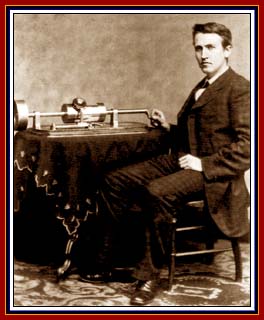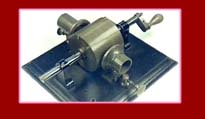
( image credit : http://www.w-pro.com/edison/ )
The turntable (or phonograph) has, since the early 1930's, evolved into an impressive piece of engineering from a physics viewpoint. Until recently (with the renewed interest in turntable technology thanks to electronic and namely hiphop music) the grand daddy of all turntables and the apogee of turntable design would most definately be the Technics SP-1200 turntable, currently enjoying a lifespan of some 25 years. This page will admire all aspects of turntable engineering including the history leading up to the 1200, the physics of the stylus, the motor that drives the platter, a brief examination of the cutting process, and of course an anecdote on uses of the turntable and vinyl medium in our time.
 the history of our beloved turntable. |
Edison's "talking aluminum" (and subsequent similar inventions) first exhibited in 1877 was originally showcased as a curiousity - a trumpet player, for instance, would play a verse into the recorder, and after a sufficient suspense was built, Edison would play back for the audience the recording of the musician's ditty. But soon this technology would evolve into the king of consumer audio media until the shameful "need" for "digital" music grasped the public conscience by the throat. |
| Of course we all know that the turntable is still a popular medium for audio and many would argue that it is the quintessential method of realizing an artist's true intentions. The strengths of the turntable to back such claims up is in its admirable sound reproduction and the consideration put into the stylii used today, and, in the case of the SP-1200 and similar high-end dj turntables, the exquisite drive system. |
|
| Without records, the turntable would be nothing more than an impressive paperweight with an interesting dot pattern on the platter. The process behind pressing 'tracks' onto vinyl is a science in itself, requiring special attention from the artist, the engineer, and of course the plant where the records are pressed. This is complicated but I am lathe to leave it out. |
 |
And of course a machine is yet a machine. The most
important part of a good record and a good record player is the man
or woman behind those 'decks.' Who or what consists of the market nowadays
to make it economically viable to press records? Why have those fools
not succumbed to the pressures of the mass media and the greed of the
record industry? Forget the links I'll tell you right now : they're
robots.
|
I hope you have enjoyed this webpage and I sincerily hope that you have learned
a thing, or two mayhaps. Enjoy the bibliography
linked thusly, for were it not for these people, I would be nothing more than
a well spoken charlatan waxing philosophic on science (dare I say a combustible
combination)
All written material © ensign wiggles 2003


